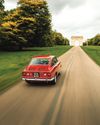
The New Year celebrations had barely faded when the great and the good of the Formula One Constructors' Association gathered at Olympia in London. They were there to give their side of the story in a dispute with race organisers, who had recently formed their own 'union' Grand Prix International. With less than a month to go before the start of the 1973 World Championship, battle lines had been drawn and it all boiled down to one thing: money.
The Constructors' Association included all of the top teams and, in effect, offered the organisers a 'package deal': we'll come to your race if you pay us a certain amount. If you don't, you get none of us. With costs going up, it said its members needed much more start and prize money to survive, and Grand Prix International said it couldn't afford it. Its argument was that much-needed improvements to both safety and spectator facilities at its circuits simply didn't leave enough in the pot.
Over the winter of 1972-'73, it seemed that the situation had reached an impasse. It was typical of a turbulent decade in which the sport moved away from old-style Grand Prix racing towards the modern, trademarked entity. known as Formula One. Great road circuits were being replaced by sterile autodromes, and financial necessity dictated that famous team names were now officially prefaced by those of their sponsors - John Player Team Lotus, Yardley McLaren and Marlboro BRM.
Into the middle of it all came Hesketh Racing, a team with zero commercial backing but money seemingly to burn, a confidently stated ambition to make James Hunt World Champion, an unashamed desire to enjoy themselves in the process, and a car that would take on a grid full of mobile billboards finished in nothing more than virginal white with patriotic flashes of red and blue.
Denne historien er fra July 2023-utgaven av Classic & Sports Car.
Start din 7-dagers gratis prøveperiode på Magzter GOLD for å få tilgang til tusenvis av utvalgte premiumhistorier og 9000+ magasiner og aviser.
Allerede abonnent ? Logg på
Denne historien er fra July 2023-utgaven av Classic & Sports Car.
Start din 7-dagers gratis prøveperiode på Magzter GOLD for å få tilgang til tusenvis av utvalgte premiumhistorier og 9000+ magasiner og aviser.
Allerede abonnent? Logg på

RAY HILLIER
Double-chevron oddity proves a break from the norm for this Crewe specialist

SHORT BACK & GLIDES
Eccentric enthusiast Captain RG McLeod's series of Manx-tailed Bentley Specials reached its zenith with this unique S2 Continental.

People's choice
The diminutive but multi-million-selling Fiat 850 packed a remarkable diversity of form and function into its compact footprint

PLASTIC BREAKS FROM THE NORM
Glassfibre revolutionised niche car-body production, but just occasionally strayed into the mainstream.

A SENSIBLE SUPERCAR
The cleverly conceived four-seater Elite secured Lotus a place at the big players' table, but has it been unfairly maligned since then?

"I had a habit of grabbing second place from the jaws of victory"
From dreams of yachting glory to the Le Mans podium, via a stint at the top of the motorsport tree, Howden Ganley had quite the career

Still going strong
Herbert Engineering staked its reputation on the five-year warranty that came with its cars. A century on, this Two Litre hasn't made a claim

One for the kids
General Motors was aiming squarely at the youth market with the launch of the Pontiac GTO 60 years ago, and its runaway success popularised the muscle-car movement

A NEW BREED OF HERO
Launched at the turn of the millennium, the GT3 badge has already earned a place alongside RS, CS and turbo in Porsche lore.

Brits with SIX appeal
The straight-six engine is synonymous with a decades-long legacy of great British sports cars. Six variations on the sextet theme convene for comparison